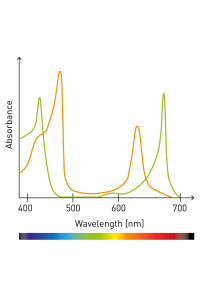UV-VIS Astaxanthin Content
- Product Code: 35598
Spectrophotometric determination of carotenoid content is a common method used to quantify the concentration of carotenoids
Measuring the Astaxanthin content using UV-VIS spectroscopy:
Materials:
1. UV-VIS spectrophotometer
2. Quartz cuvettes
3. Astaxanthin sample
4. Solvent (ethanol)
5. Distilled water
6. Wavelength range: Typically, Astaxanthin absorbs light in the range of 400-550 nm.
Procedure:
1. **Preparation of Astaxanthin Solution**:
- Weigh an appropriate amount of Astaxanthin sample accurately (usually around 1-10 mg depending on the concentration).
- Dissolve the Astaxanthin sample in a suitable solvent (ethanol is commonly used) to prepare a stock solution. The concentration should be adjusted to fall within the linear range of the UV-VIS spectrophotometer.
2. **Blank Solution**:
- Prepare a blank solution using the same solvent (ethanol) without Astaxanthin. This is to calibrate the instrument and account for any absorbance by the solvent.
3. **Baseline Correction**:
- Place a quartz cuvette containing the blank solution into the spectrophotometer.
- Adjust the wavelength range to include the absorption maximum of Astaxanthin (around 400-550 nm).
- Perform a baseline correction by setting the absorbance to zero at the chosen wavelength.
4. **Sample Measurement**:
- After baseline correction, remove the cuvette containing the blank solution and replace it with a cuvette containing the Astaxanthin solution.
- Measure the absorbance of the Astaxanthin solution at the same wavelength as the baseline correction.
5. **Data Analysis**:
- Using the absorbance values obtained from the spectrophotometer, calculate the concentration of Astaxanthin in the sample using Beer-Lambert law:
6. **Validation**:
- Validate the obtained concentration values by comparing with known standards or by repeating the measurements.
7. **Reporting**:
- Report the concentration of Astaxanthin in the sample along with any relevant experimental details (solvent used, wavelength of measurement, etc.).
| Step | Procedure | Expected Result | |||
|---|---|---|---|---|---|
| There is no item to display. | |||||
Spectrophotometric determination of carotenoid content is a common method used to quantify the concentration of carotenoids
Measuring the Astaxanthin content using UV-VIS spectroscopy:
Materials:
1. UV-VIS spectrophotometer
2. Quartz cuvettes
3. Astaxanthin sample
4. Solvent (ethanol)
5. Distilled water
6. Wavelength range: Typically, Astaxanthin absorbs light in the range of 400-550 nm.
Procedure:
1. **Preparation of Astaxanthin Solution**:
- Weigh an appropriate amount of Astaxanthin sample accurately (usually around 1-10 mg depending on the concentration).
- Dissolve the Astaxanthin sample in a suitable solvent (ethanol is commonly used) to prepare a stock solution. The concentration should be adjusted to fall within the linear range of the UV-VIS spectrophotometer.
2. **Blank Solution**:
- Prepare a blank solution using the same solvent (ethanol) without Astaxanthin. This is to calibrate the instrument and account for any absorbance by the solvent.
3. **Baseline Correction**:
- Place a quartz cuvette containing the blank solution into the spectrophotometer.
- Adjust the wavelength range to include the absorption maximum of Astaxanthin (around 400-550 nm).
- Perform a baseline correction by setting the absorbance to zero at the chosen wavelength.
4. **Sample Measurement**:
- After baseline correction, remove the cuvette containing the blank solution and replace it with a cuvette containing the Astaxanthin solution.
- Measure the absorbance of the Astaxanthin solution at the same wavelength as the baseline correction.
5. **Data Analysis**:
- Using the absorbance values obtained from the spectrophotometer, calculate the concentration of Astaxanthin in the sample using Beer-Lambert law:
6. **Validation**:
- Validate the obtained concentration values by comparing with known standards or by repeating the measurements.
7. **Reporting**:
- Report the concentration of Astaxanthin in the sample along with any relevant experimental details (solvent used, wavelength of measurement, etc.).
| Mechanism | - |
| Appearance | - |
| Longevity | - |
| Strength | - |
| Storage | - |
| Shelf Life | - |
| Allergen(s) | - |
| Dosage (Range) | - |
| Recommended Dosage | - |
| Dosage (Per Day) | - |
| Recommended Dosage (Per Day) | - |
| Mix Method | - |
| Heat Resistance | - |
| Stable in pH range | - |
| Solubility | - |
| Product Types | - |
| INCI | - |
Cart
No products



